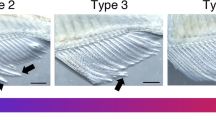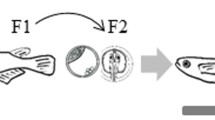Abstract
In this study, the biologic effects of DES on the early life and adult life stages of Japanese medaka (Oryzias latipes) were evaluated. At the early life stage, the fertilized eggs were exposed to 1–1000 ng/L diethylstilbestrol (DES) for 15 days and the hatched larvae were continually exposed to the same concentrations for an additional 25 days. Significant adverse effects on hatchability, time to hatching and mortality rate occurred at DES concentrations of 100 and 1000 ng/L, while the abnormality (scoliosis and abdominal swelling) rate was significantly increased at 10 ng/L and above. After exposure, the fish were maintained in charcoal-dechlorinated tap water for a further 30 days. Only the male gonadosomatic index (GSI) at 1000 ng/L was significantly increased. At concentrations greater than 1 ng/L, estrogen receptor α (ERα) mRNA in both sexes and vitellogenin-I (Vtg-I) mRNA in males were significantly down-regulated; while Vtg-I mRNA in females was significantly up-regulated. When sexually mature medaka were exposed to 10 and 1000 ng/L DES for 21 days, only the GSI in females was significantly decreased at 1000 ng/L. At 10 and 1000 ng/L, ERα mRNA in both sexes was significantly down-regulated, while Vtg-I mRNA in males was significantly up-regulated. These findings showed that DES at the environmental concentration of 10 ng/L can affect the early life stage development of medaka and alter liver ERα and Vtg-I gene expression. Therefore, if we only focused on these sensitive toxicity endpoints such as ERα and Vtg-I mRNA expression, DES has a strong estrogenic effect on Japanese medaka.


Similar content being viewed by others
References
Adedeji OB, Durhan EJ, Garcia-Reyero N, Kahl MD, Jensen KM et al (2012) Short-term study investigating the estrogenic potency of diethylstilbesterol in the fathead minnow (Pimephales promelas). Environ Sci Technol 46:7826–7835
An J, Ribeiro RC, Webb P, Gustafsson JA, Kushner PJ et al (1999) Estradiol repression of tumor necrosis factor-alpha transcription requires estrogen receptor activation function-2 and is enhanced by coactivators. Proc Natl Acad Sci USA 96:15161–15166
Andreassen TK, Skjoedt K, Korsgaard B (2005) Upregulation of estrogen receptor α and vitellogenin in eelpout (Zoarces viviparous) by waterborne exposure to 4-tert-octylphenol and 17β-estradiol. Comp Biochem Physiol C 140:340–346
Arukwe A, Kullman SW, Hinton DE (2001) Differential biomarker gene and protein expressions in nonylphenol and estradiol-17β treated juvenile rainbow trout (Oncorhynchus mykiss). Comp Biochem Physiol C 129:1–10
Atteke C, Vetillard A, Fostier A, Garnier DH, Jego P et al (2003) Effect of progesterone and estradiol on the reproductive axis in immature diploid and triploid rainbow trout. Comp Biochem Physiol A 134:693–705
Bhandari RK, Hig M, Komuro H, Nakamura S, Nakamura M (2003) Treatment with an aromatase inhibitor induces complete sex change in the protogynous honeycomb grouper (Epinephelus merra). Fish Physiol Biochem 28:141–142
Boyce-Derricott J, Nagler JJ, Cloud JG (2009) Regulation of hepatic estrogen receptor isoform mRNA expression in rainbow trout (Oncorhynchus mykiss). Gen Comp Endocr 161:73–78
Brieno-Enriquez MA, Reig-Viader R, Cabero L (2012) Gene expression is altered after bisphenol A exposure in human fetal oocytes in vitro. Mol Hum Reprod 18:171–183
Chakraborty T, Katsu Y, Zhou LY, Miyagawa S, Nagahama Y et al (2011) Estrogen receptors in medaka (Oryzias latipes) and estrogenic environmental contaminants: an in vitro in vivo correlation. J Steroid Biochem 123:115–121
Chen TS, Chen TC, Yeh KJ, Chao HR, Liaw ET et al (2010) High estrogen concentrations in receiving river discharge from a concentrated livestock feedlot. Sci Total Environ 408:3223–3230
Edmunds JS, McCarthy RA, Ramsdell JS (2000) Permanent and functional male to female sex reversal in d-rR strain medaka (Oryzias latipes) following egg microinjection of o,p’-DDT. Environ Health Perspect 108:219–224
Flouriot G, Pakdel F, Ducouret B, Ledrean Y, Valotaire Y (1997) Differential regulation of two genes implicated in fish reproduction: vitellogenin and estrogen receptor genes. Mol Reprod Dev 48:317–323
Hawkins MB, Thornton JW, Crews D, Skipper JK, Dotte A et al (2000) Identification of a third distinct estrogen receptor and reclassification of estrogen receptors in teleosts. Proc Natl Acad Sci USA 97:10751–10756
Huang C, Zhang ZB, Wu SM, Zhao YB, Hu JY (2010) In vitro and in vivo estrogenic effects of 17α-estradiol in medaka (Oryzias latipes). Chemosphere 80:608–612
Ishibashi H, Matsumura N, Hirano M, Matsuoka M, Shiratsuchi H et al (2004) Effects of triclosan on the early life stages and reproduction of medaka Oryzias latipes and induction of hepatic vitellogenin. Aquat Toxicol 67:167–179
Ishibashi H, Yamauchi R, Matsuoka M, Kim JW, Hirano M et al (2008) Fluorotelomer alcohols induce hepatic vitellogenin through activation of the estrogen receptor in male medaka (Oryzias latipes). Chemosphere 71:1853–1859
Kishi K, Kitagawa E, Onikura N, Nakamura A, Iwahashi H (2006) Expression analysis of sex-specific and 17β-estradiol-responsive genes in the Japanese medaka, Oryzias latipes, using oligonucleotide microarrays. Genomics 88:241–251
Kuster M, Lόpez de Alda MJ, Barcelό D (2004) Analysis and distribution of estrogens and progestogens in sewage sludge, soils and sediments. Trend Anal Chem 23:790–798
Lange A, Katsu Y, Miyagawa S, Ogino Y, Urushitani H et al (2012) Comparative responsiveness to natural and synthetic estrogens of fish species commonly used in the laboratory and field monitoring. Aquat Toxicol 109:250–258
Lee W, Kang CW, Su CK, Okubo K, Nagahama Y (2012) Screening estrogenic activity of environmental contaminants and water samples using a transgenic medaka embryo bioassay. Chemosphere 88:945–952
Lei BL, Huang SB, Zhou YQ, Wang DH, Wang ZJ (2009) Levels of six estrogens in water and sediment from three rivers in Tianjin area, China. Chemosphere 6:36–42
Lei BL, Kang J, Yu YX, Zha JM, Li W et al (2013a) β-estradiol 17-valerate affects embryonic development and sexual differentiation in Japanese medaka (Oryzias latipes). Aquat Toxicol 134–135:128–134
Lei BL, Wen Y, Wang XT, Zha JM, Li W et al (2013b) Effects of estrone on the early life stages and expression of vitellogenin and estrogen receptor genes of Japanese medaka (Oryzias latipes). Chemosphere 93:1104–1110
Lei BL, Kang J, Yu YX, Zha JM, Li W et al (2014) Long-term exposure investigating the estrogenic potency of estriol in Japanese medaka (Oryzias latipes). Comp Biochem Physiol C 160:86–92
Luo JP, Lei BL, Ma M, Zha JM, Wang ZJ (2011) Identification of estrogen receptor agonists in sediments from Wenyu River, Beijing, China. Water Res 45:3908–3914
Matozzo V, Gagné F, Marin MG, Ricciardi F, Blaise C (2008) Vitellogenin as a biomarker of exposure to estrogenic compounds in aquatic invertebrates: a review. Environ Int 34:531–545
Mitsui N, Tooi O, Kawahara A (2007) Vitellogenin-inducing activities of natural, synthetic, and environmental estrogens in primary cultured Xenopus laevis hepatocytes. Comp Biochem Physiol C 146:581–587
Nakamura I, Kusakabe M, Young G (2009) Differential suppressive effects of low physiological doses of estradiol-17β in vivo on levels of mRNAs encoding steroidogenic acute regulatory protein and three steroidogenic enzymes in previtellogenic ovarian follicles of rainbow trout. Gen Comp Endocr 163:318–323
Panter GH, Hutchinson TH, Lange R, Lye CM, Sumpter JP et al (2002) Utility of a juvenile fathead minnow screening assay for detecting (anti-) estrogenic substances. Environ Toxicol Chem 21:319–326
Paul-Prasanth B, Shibata Y, Horiguchi R, Nagahama Y (2011) Exposure to diethylstilbestrol during embryonic and larval stages of medaka fish (Oryzias latipes) leads to sex reversal in genetic males and reduced gonad weight in genetic females. Endocrinology 152:707–717
Petit FG, Metivier R, Valotaire Y, Pakdel F (1999) Synergism between a half-site and an imperfect estrogen-responsive element, and cooperation with COUP-TFI are required for estrogen receptor (ER) to achieve a maximal estrogen-stimulation of rainbow trout ER gene. Eur J Biochem 259:385–395
Pettersson I, Arukweb A, Lundstedt-Enkel K, Mortensen AS, Berg C (2006) Persistent sex-reversal and oviducal agenesis in adult Xenopus (Silurana) tropicalis frogs following larval exposure to the environmental pollutant ethynylestradiol. Aquat Toxicol 79:356–665
Pojana G, Gomiero A, Jonkers N, Marcomini A (2007) Natural and synthetic endocrine disrupting compounds (EDCs) in water, sediment and biota of a coastal lagoon. Environ Int 33:929–936
Potts AC, Phelps RP (1995) Use of diethylstilbestrol and ethynylestradiol to feminize Nile tilapia Oreochromis niloticus (L.) in an outdoor environment. J Appl Ichthyol 11:111–117
Scholz S, Gutzeit HO (2000) 17-alpha-ethinylestradiol affects reproduction, sexual differentiation and aromatase gene expression of the medaka (Oryzias latipes). Aquat Toxicol 50:363–373
Seki M, Yokota H, Matsubara H, Tsuruda Y, Maeda M et al (2002) Effect of ethinylestradiol on the reproduction and induction of vitellogenin and testis-ova in medaka (Oryzias latipes). Environ Toxicol Chem 21:1692–1698
Sun LW, Zha JM, Spear PA, Wang ZJ (2007) Tamoxifen effects on the early life stages and reproduction of Japanese medaka (Oryzias latipes). Environ Toxicol Pharm 24:23–29
Wang L, Ying GG, Zhao JL, Liu S, Yang B et al (2011) Assessing estrogenic activity in surface water and sediment of the Liao River system in northeast China using combined chemical and biological tool. Environ Pollut 159:148–156
Yang L, Lin L, Wang S, Feng Z, Luan T (2008) Sexually disrupting effects of nonylphenol and diethylstilbestrol on male silver carp (Carassius auratus) in aquatic microcosms. Ecotoxicol Environ Saf 71:400–411
Zha J, Sun L, Zhou Y, Spear P, Ma M et al (2008) Assessment of 17a-ethinylestradiol effects and underlying mechanisms in a continuous, multigeneration exposure of the Chinese rare minnow (Gobiocypris rarus). Toxicol Appl Pharm 226:298–308
Zhang ZB, Hu JY (2008) Effects of p,p′-DDE exposure on gonadal development and gene expression in Japanese medaka (Oryzias latipes). J Environ Sci 20:347–352
Zhang XY, Zha JM, Li W, Yang LH, Wang ZJ (2008a) Effects of 2,4-dichlorophenol on the expression of vitellogenin and estrogen receptor genes and physiology impairments in Chinese rare Minnow (Gobiocypris rarus). Environ Toxicol 23:694–701
Zhang XY, Zha JM, Wang ZJ (2008b) Influences of 4-nonylphenol on doublesex- and mab-3-related transcription factor 1 gene expression and vitellogenin mRNA induction of adult rare minnow (Gobiocypris rarus). Environ Toxicol Chem 27:196–205
Zhong X, Xu Y, Liang Y, Liao T, Wang J (2005) The Chinese rare minnow (Gobiocypris rarus) as an in vivo model for endocrine disruption in freshwater teleosts: a full life-cycle test with diethylstilbestrol. Aquat Toxicol 71:85–95
Acknowledgments
We gratefully acknowledge the supports of the National Natural Science Foundation of China (Nos. 21507078, 41430644), the Program for Changjiang Scholars and Innovative Research Team in University (No. IRT13078) and the Open Fund of State Key Laboratory of Organic Geochemistry (No. OGL-201410). At the same time, the authors are grateful for the contributions of Wang ZJ, Zha JM from the State Key Laboratory of Environmental Aquatic Chemistry, Research Center for Eco-Environmental Sciences, Chinese Academy of Sciences, for providing technical support to these experiments.
Author information
Authors and Affiliations
Corresponding author
Ethics declarations
Conflict of interest
The authors declare that they have no conflict of interest.
Ethical approval
Any studies in this paper using Japanese medaka fish were conducted in accordance with national and institutional guidelines for the protection of human subjects and animal welfare.
Rights and permissions
About this article
Cite this article
Lei, B., Peng, W., Li, W. et al. Diethylstilbestrol at environmental levels affects the development of early life stage and target gene expression in Japanese Medaka (Oryzias latipes). Ecotoxicology 25, 563–573 (2016). https://doi.org/10.1007/s10646-016-1615-0
Accepted:
Published:
Issue Date:
DOI: https://doi.org/10.1007/s10646-016-1615-0




